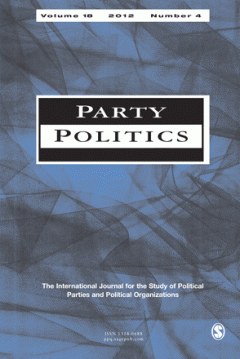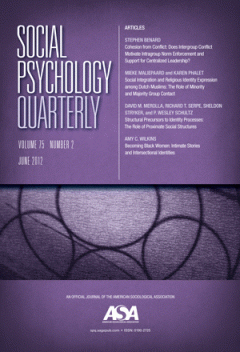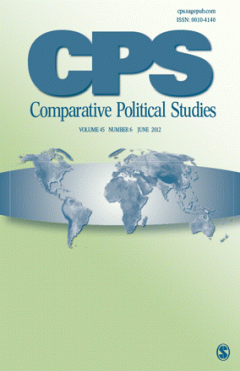Filter by

Newness as a winning formula for new political parties
Previous studies on new political parties have assumed that they either represent new or ignored cleavages or issues, or emerge in order to cleanse an ideology deficiently represented by an existing party. Four highly successful parties analyzed in this article manifestly fail to comply with these assumptions. The article proposes a parsimonious two-dimensional typology of new parties refining …
- Edition
- Volume 18, Number 4, July 2012 p. 465-486
- ISBN/ISSN
- 1354-0688
- Collation
- p. 465-486
- Series Title
- Party Politics
- Call Number
- -

Political market orientation: A framework for understanding relationship stru…
This article is motivated by the growing need to integrate the current political science and marketing literature in order to provide a deeper understanding of the behaviour of political actors and their relationships with relevant stakeholder groups. In our article, we demonstrate how Ormrod�s conceptual model of political market orientation complements political science models of party organi…
- Edition
- Volume 18, Number 4, July 2012 p. 487-502
- ISBN/ISSN
- 1354-0688
- Collation
- p. 487-502
- Series Title
- Party Politics
- Call Number
- -

Legislative organization in MMP: The case of New Zealand
How do electoral systems affect legislative organization? The change in electoral systems from Single Member District plurality (SMD) to Mixed Member Proportional (MMP) in New Zealand can illuminate how electoral incentives affect the distribution of cabinet positions. Because in SMD the outcome of individual local districts determines the number of seats a party wins collectively, New Zealand …
- Edition
- Volume 18, Number 4, July 2012 p. 503-521
- ISBN/ISSN
- 1354-0688
- Collation
- p. 503-521
- Series Title
- Party Politics
- Call Number
- -

How many political parties are there, really? A new measure of the ideologica…
We offer a new measure of the ideologically cognizable number of political parties/party groupings that is intended to be complementary to the standard approach to counting the effective number of political parties � the Laakso�Taagepera index (1979). This approach allows the possibility of precise measurement of concepts such as polarized pluralism or fragmented bipolarism and is applicable to…
- Edition
- Volume 18, Number 4, July 2012 p. 523-544
- ISBN/ISSN
- 1354-0688
- Collation
- p. 523-544
- Series Title
- Party Politics
- Call Number
- -

The paradoxical effects of decline Assessing party system change and the rol…
This article examines the impact of party system change in Germany on the role, status and power of the two catch-all parties (CDU/CSU and SPD) in the light of the 2009 federal election. It argues that party system change has had a paradoxical impact. On the one hand, the decline in the overall catch-all vote undermines the two parties� integrative function. On the other, the presence of three …
- Edition
- Volume 18, Number 4, July 2012 p. 545-562
- ISBN/ISSN
- 1354-0688
- Collation
- p. 545-562
- Series Title
- Party Politics
- Call Number
- -

Electoral regimes and party-switching: Floor-crossing in South Africa's local…
This article presents an inquiry into the causes of party-switching under two different electoral regimes. It exploits a natural experiment in South Africa, where a large number of local legislatures are elected using the same mixed system, to examine how the party-switching behaviours of legislators elected under proportional representation (PR) rules may differ systematically from those of le…
- Edition
- Volume 18, Number 4, July 2012 p. 563-579
- ISBN/ISSN
- 1354-0688
- Collation
- p. 563-579
- Series Title
- Party Politics
- Call Number
- -

Gendered nationalism: The gender gap in support for the Scottish National Party
Recent major surveys of the Scottish electorate and of Scottish National Party (SNP) members have revealed a distinct gender gap in support for the party. Men are markedly more likely than women to vote for the SNP and they comprise more than two-thirds of its membership. In this article, we use data from those surveys to test various possible explanations for the disproportionately male suppor…
- Edition
- Volume 18, Number 4, July 2012 p. 581-601
- ISBN/ISSN
- 1354-0688
- Collation
- p. 581-601
- Series Title
- Party Politics
- Call Number
- -

Party organization and concurrent multi-level local campaigning: The 2007 Sco…
Parties often have to campaign for two or more levels of office at the same time. However, declining levels of organization means that the demands of concurrent elections can potentially increase the demands on volunteer party organizations considerably. These demands are multiplied by the concurrent use of different electoral systems which provide party organizations with different incentives.…
- Edition
- Volume 18, Number 4, July 2012 p. 603-622
- ISBN/ISSN
- 1354-0688
- Collation
- p. 603-622
- Series Title
- Party Politics
- Call Number
- -

Public deliberation in action: Emotion, inclusion and exclusion in participat…
Participatory forums, in which lay citizens or users of public services contribute to the governance of public services, have proliferated in recent years. In debates about the quality and influence of such processes, there has been increasing recognition of the importance of emotional as well as rational deliberation, and criticism of the way in which the structures imposed on such forums can …
- Edition
- Volume 32, Number 2, May 2012 p. 163-183
- ISBN/ISSN
- 0261-0183
- Collation
- p. 163-183
- Series Title
- Critical Social Policy
- Call Number
- -

Across a thick white line: The relationship of a Welsh medium school and a lo…
Two of the most important social policy agendas of the Welsh state in the contemporary period are the attempt to revitalize the Welsh language � through the promotion of Welsh medium education, in particular � and the effort to eliminate regional inequality and poverty � most recently, through the government�s Communities First programme. This article recounts the history of a cool and sometime…
- Edition
- Volume 32, Number 2, May 2012 p. 184-202
- ISBN/ISSN
- 0261-0183
- Collation
- p. 184-202
- Series Title
- Critical Social Policy
- Call Number
- -

What is an ‘adult protection’ issue? Victims, perpetrators and the profes…
Drawing on data from a Scottish research study, this paper explores the relationship of professionals� perceptions about specific perpetrators and victims to their constructions of �adult protection� issues in practice. It finds that professionals� perceptions of victim distress did not consistently coincide with the construction of adult protection issues, whilst the connection to any assessme…
- Edition
- Volume 32, Number 2, May 2012 p. 203-222
- ISBN/ISSN
- 0261-0183
- Collation
- p. 203-222
- Series Title
- Critical Social Policy
- Call Number
- -

‘Troops to Teachers’: Solving the problem of working-class masculinity in…
The UK government�s White Paper on Education, The Importance of Teaching (2010), includes a proposal (Troops to Teachers) to encourage ex-service personnel to train as teachers: this paper presents a critical analysis of the discussions promoting the initiative. Firstly, it is argued that the initiative attempts a rapprochement between �reputation� and �respectability� (McDowell, 2003) by prese…
- Edition
- Volume 32, Number 2, May 2012 p. 223-241
- ISBN/ISSN
- 0261-0183
- Collation
- p. 223-241
- Series Title
- Critical Social Policy
- Call Number
- -

Personal assistance for disabled people and the understanding of human being
This paper explores personal assistance � a practice considered crucial for supporting the independence and social inclusion of disabled people. The starting point of the analysis is the presumption that the significance of personal assistance goes well beyond welfare, touching upon existential-ontological issues. In order to uncover these issues, a phenomenological approach is used. The aim is…
- Edition
- Volume 32, Number 2, May 2012 p. 242-261
- ISBN/ISSN
- 0261-0183
- Collation
- p. 242-261
- Series Title
- Critical Social Policy
- Call Number
- -

Cohesion from Conflict: Does Intergroup Conflict Motivate Intragroup Norm Enf…
Classic work suggests that intergroup conflict increases intragroup cohesion and cooperation. But how do group members respond when their peers refuse to cooperate? Simmel ([1908] 1955) argued that groups in conflict quell dissent by sanctioning group members and supporting centralized leadership systems. This claim has important implications, but little direct support. This research investigat…
- Edition
- Volume 75, Number 2, June 2012 p. 107-130
- ISBN/ISSN
- 0190-2725
- Collation
- p. 107-130
- Series Title
- Social Psychology Quarterly
- Call Number
- -

Social Integration and Religious Identity Expression among Dutch Muslims: The…
Against the background of contrasting religious versus secular norms in immigrant communities and in Dutch society, this study examines how religious identity expression is related to the social integration of Dutch Muslims within (a) Turkish or Moroccan minority groups and (b) Dutch majority groups. Using nationally representative survey data (N = 2,027), we distinguish religious identificatio…
- Edition
- Volume 75, Number 2, June 2012 p. 131-148
- ISBN/ISSN
- 0190-2725
- Collation
- p. 131-148
- Series Title
- Social Psychology Quarterly
- Call Number
- -

Structural Precursors to Identity Processes: The Role of Proximate Social Str…
This research investigates how participation in college-based science-training programs increases student intention to pursue a scientific career. Using identity theory, we delineate three levels of social structure and conceptualize science-training programs as proximate social structures. Results from a sample of 892 undergraduate science students are supportive of identity theory and indicat…
- Edition
- Volume 75, Number 2, June 2012 p. 149-172
- ISBN/ISSN
- 0190-2725
- Collation
- p. 149-172
- Series Title
- Social Psychology Quarterly
- Call Number
- -

Becoming Black Women: Intimate Stories and Intersectional Identities
In this article, I argue that intimate stories are an important resource for the achievement of intersectional identities. Drawing on in-depth interviews with black college students at two predominantly white universities, I examine the stories black college women tell about interracial relationships between black men and white women. I argue that interracial stories serve an array of social pu…
- Edition
- Volume 75, Number 2, June 2012 p. 173-196
- ISBN/ISSN
- 0190-2725
- Collation
- p. 173-196
- Series Title
- Social Psychology Quarterly
- Call Number
- -

Authoritarian Responses to Foreign Pressure: Spending, Repression, and Sanctions
This article explores how international sanctions affect authoritarian rulers� decisions concerning repression and public spending composition. Rulers whose budgets are not severely constrained by sanctions will tend to increase spending in those categories that most benefit their core support groups. When budget constraints are severe, dictators are more likely to increase repression. Using da…
- Edition
- Volume 45 Number 6 June 2012 p. 683-713
- ISBN/ISSN
- 0010-4140
- Collation
- p. 683-713
- Series Title
- Comparative Political Studies
- Call Number
- -

Left Parties, Poor Voters, and Electoral Participation in Advanced Industrial…
Although income inequality is an important normative issue for students of democratic politics, little is known about its effects on citizens� electoral participation. The authors develop a formal model of the incentives for left parties to mobilize lower income voters. It posits that countries� income distributions and competition on the left provide different incentives for left parties to mo…
- Edition
- Volume 45 Number 6 June 2012 p. 714-746
- ISBN/ISSN
- 0010-4140
- Collation
- p. 714-746
- Series Title
- Comparative Political Studies
- Call Number
- -

Reverse Contamination: Burning and Building Bridges in Mixed-Member Systems
Why would a candidate in a mixed-member electoral system willingly forego the chance to be dual listed in the party list tier along with the single-member district tier? Mixed-member systems create a �reverse contamination effect� through which list rankings provide important information to voters and thus influence behavior in the nominal tier. Rankings signal importance of the candidate withi…
- Edition
- Volume 45 Number 6 June 2012 p. 747-773
- ISBN/ISSN
- 0010-4140
- Collation
- p. 747-773
- Series Title
- Comparative Political Studies
- Call Number
- -
 Computer Science, Information & General Works
Computer Science, Information & General Works  Philosophy & Psychology
Philosophy & Psychology  Religion
Religion  Social Sciences
Social Sciences  Language
Language  Pure Science
Pure Science  Applied Sciences
Applied Sciences  Art & Recreation
Art & Recreation  Literature
Literature  History & Geography
History & Geography